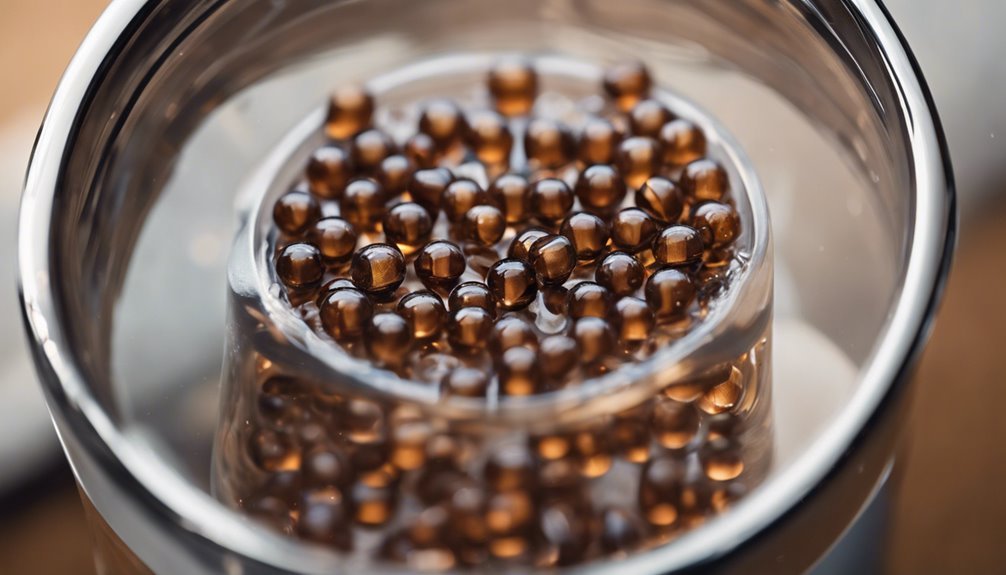What Are the Brown Beads in a Portable Water Softner?
When you think about the brown beads in a portable water softener, you might wonder what they're really made of and how they work. These beads play a vital role in the ion exchange process, replacing hard minerals in your water with sodium ions. Understanding their composition and function can shed light on why they're essential for maintaining the efficiency of your softener. But what happens when these beads start to lose their effectiveness? Exploring that question can reveal important insights about your water quality and the longevity of your softener.
Key Takeaways
- Brown beads in a portable water softener are made from durable polystyrene and divinylbenzene resin, ensuring resistance to chemical degradation.
- These beads perform ion exchange, replacing calcium and magnesium ions in hard water with sodium ions to create softened water.
- The efficiency of the brown beads is crucial for water softening and requires regular regeneration with a salt solution to maintain performance.
- Regular maintenance includes rinsing beads monthly and inspecting for damage to ensure effective operation and longevity of the water softener.
- Brown beads improve water quality, enhance cleaning efficiency, and reduce the need for harsh chemicals in water treatment processes.
Composition of Brown Beads
Brown beads in a portable water softener primarily consist of a unique resin made from polystyrene and divinylbenzene. This composition gives the beads their specific material properties, such as high durability and resistance to chemical degradation.
You'll find that these beads come in various bead types, each designed to optimize the water softening process. The polystyrene provides a stable backbone, while the divinylbenzene cross-links the polymer chains, enhancing the structural integrity of the resin.
This combination allows the beads to maintain their shape and functionality even under pressure and over extended use. You'll notice that the size and uniformity of the beads are essential as they influence the efficiency of ion exchange.
These material properties make the brown beads particularly effective at capturing hard water minerals like calcium and magnesium. Their surface area plays a critical role, as larger areas allow for more ions to be exchanged simultaneously.
When selecting a portable water softener, understanding the composition of these beads helps you appreciate their effectiveness and longevity. This knowledge guarantees you make an informed choice for your water treatment needs.
Function of Brown Beads
The function of the brown beads in a portable water softener revolves around their ability to perform ion exchange, which is essential for reducing water hardness. This process allows the beads to effectively replace calcium and magnesium ions with sodium ions, resulting in softened water. The efficiency of these beads is paramount, as it directly impacts the overall performance of your water softener.
Here's a quick overview of how bead efficiency and softener lifespan are related:
| Bead Efficiency | Softener Lifespan |
|---|---|
| High efficiency leads to better ion exchange, improving softness. | A well-maintained unit lasts longer, saving you costs. |
| Regular regeneration maintains bead performance and efficiency. | Frequent replacements shorten the softener's lifespan. |
| Impurities can reduce bead efficiency, necessitating cleaning. | Increased efficiency prolongs the softener's operational life. |
How Water Softening Works
Water softening primarily relies on the ion exchange process, where hard water minerals like calcium and magnesium are replaced with sodium ions.
As water flows through the softener, these brown beads attract and hold the hardness minerals, effectively removing them from the water supply.
This process results in softer water, which can enhance your plumbing and improve the effectiveness of soaps and detergents.
Ion Exchange Process
Ion exchange is an essential mechanism in the process of water softening, effectively removing hard minerals like calcium and magnesium from your water supply. This process relies on the unique properties of ion exchange resins, which play a pivotal role in altering water chemistry.
Here's how it works:
- Resin Composition: The brown beads in your portable water softener are made of resin that's charged with sodium ions.
- Ion Exchange Reaction: As hard water passes through the resin, calcium and magnesium ions in the water swap places with the sodium ions attached to the resin.
- Softened Water Output: The result? You get softened water with notably reduced hardness, improving your water quality for various uses.
- Regeneration Cycle: Eventually, the resin becomes saturated with calcium and magnesium. To restore its effectiveness, you'll need to regenerate the resin using a salt solution, replenishing the sodium ions.
Understanding this ion exchange process is vital for maintaining your water softener's efficiency, ensuring you consistently enjoy the benefits of softened water.
Hardness Minerals Removal
Removing hardness minerals from your water supply is a straightforward process that directly enhances water quality. When you deal with hard water, you're often faced with mineral buildup from calcium and magnesium. These minerals can lead to various issues, including scale in pipes and appliances, reduced soap efficiency, and unpleasant water taste.
Portable water softeners utilize the ion exchange process to tackle this problem effectively. As water flows through the softener, it passes over the brown beads, which are typically made of resin. These beads are charged with sodium ions.
When hard water enters the system, calcium and magnesium ions swap places with the sodium ions on the beads. This exchange removes hardness minerals from your water, effectively softening it.
Once the beads become saturated with hardness minerals, they need to be regenerated. This process involves flushing the beads with a brine solution, which replenishes the sodium ions and removes the accumulated hardness minerals.
Importance of Ion Exchange
A significant aspect of portable water softeners is the ion exchange process, which plays an integral role in reducing hard water minerals. This process directly impacts water chemistry, making it essential for peak performance. By exchanging calcium and magnesium ions for sodium or potassium ions, you effectively transform hard water into soft water.
Here are four reasons why ion exchange is critical:
- Efficiency: Ion exchange effectively targets and removes hardness minerals, ensuring your water is soft and suitable for various applications.
- Cost-Effective: Using a portable water softener reduces the need for expensive plumbing repairs and extends the lifespan of appliances that use water.
- Improved Cleaning: Softened water enhances the effectiveness of soaps and detergents, leading to better cleaning results and less soap scum.
- Environmental Impact: By minimizing the use of harsh chemicals for softening, you contribute to a more sustainable approach to water treatment.
Understanding the importance of ion exchange in your portable water softener will help you appreciate its role in achieving high-quality water for everyday use.
Maintenance of Brown Beads
Maintaining the brown beads in your portable water softener is vital for peak performance and longevity. Regular bead maintenance guarantees that the ion exchange process operates efficiently, providing you with soft water consistently. Here are some key steps for proper cleaning and upkeep:
| Maintenance Task | Frequency |
|---|---|
| Rinse the beads | Monthly |
| Inspect for damage | Every 3 months |
| Refill salt or resin | As needed |
| Regenerate softener | Every 6 weeks |
| Clean the resin tank | Annually |
To rinse the beads, simply run clean water through the system to remove any accumulated impurities. Regular inspections help you identify cracks or wear, which can affect performance. Refilling salt or resin is vital, as depleted materials can hinder ion exchange efficiency. Don't forget to regenerate your softener to keep the beads functioning at their best. Cleaning the resin tank annually prevents buildup that could impair performance. Following these maintenance tips will not only extend the life of your brown beads but also guarantee you enjoy the full benefits of your portable water softener.
Signs of Depleted Beads
Recognizing the signs of depleted beads is essential for guaranteeing your portable water softener continues to deliver peak performance. When the beads lose their effectiveness, you'll notice several indicators that prompt you to initiate the regeneration process.
- Hard Water Indicators: If you're experiencing soap scum buildup or mineral deposits on fixtures, it's a clear sign the beads are depleted.
- Decreased Water Flow: A noticeable drop in water pressure might indicate that the resin beads are saturated and unable to soften water effectively.
- Increased Sodium Levels: If you detect a salty taste in your water, your softener could be struggling due to depleted beads, leading to incomplete regeneration.
- Frequent Regeneration Needs: If you find yourself needing to regenerate your system more often than before, it's time to evaluate the condition of the beads.
Regularly monitoring these signs will help you maintain peak performance from your portable water softener.
Addressing depleted beads promptly guarantees that your system remains effective, providing you with soft water and protecting your plumbing from mineral buildup.
Environmental Impact
Using brown beads in a portable water softener considerably improves water quality by reducing hardness and preventing scale buildup.
This not only enhances the efficiency of plumbing systems but also conserves resources by minimizing the need for excessive water treatment.
Furthermore, the reduction in chemical usage leads to a lower environmental impact, making the system more sustainable for everyday use.
Water Quality Improvement
A portable water softener greatly enhances water quality by effectively removing hardness minerals, such as calcium and magnesium. This process not only improves the taste and feel of your water but also protects your plumbing systems and appliances from scale buildup.
Here are some key benefits of using a portable softener:
- Enhanced Taste: Softened water has a smoother taste, making it more pleasant for drinking and cooking.
- Improved Lathering: You'll notice that soap and detergents lather better in soft water, leading to more effective cleaning.
- Reduced Scale Buildup: By removing hardness minerals, a portable softener helps prevent the formation of scale in pipes, which can lead to costly repairs.
- Longer Appliance Lifespan: Softened water can extend the life of appliances, such as dishwashers and water heaters, by reducing the wear and tear caused by mineral deposits.
Resource Conservation Benefits
Portable water softeners not only enhance your water quality but also contribute considerably to resource conservation. By reducing hardness in your water supply, these units help eliminate scale buildup in pipes and appliances. This means you'll use less water for cleaning and maintenance, leading to significant water conservation over time.
Furthermore, when you soften your water, it requires fewer detergents and soaps to achieve the same cleaning effectiveness. This not only conserves water used in rinsing but also minimizes the volume of chemicals entering the wastewater system, promoting better resource management.
In addition, by extending the lifespan of your plumbing and appliances, portable water softeners reduce the need for repairs or replacements, which conserves materials and energy associated with manufacturing new units.
Ultimately, investing in a portable water softener aligns with sustainable practices, allowing you to manage resources more efficiently. By making this choice, you're not just improving your household's water quality; you're also actively participating in broader environmental conservation efforts.
The cumulative impact of these small changes can lead to significant benefits for both your home and the planet.
Chemical Usage Reduction
While many households rely on various cleaning agents to tackle hard water issues, investing in a water softener can greatly reduce the need for these chemicals.
By enhancing softening efficiency, water softeners minimize your reliance on chemical alternatives that can harm the environment.
Here are four key benefits of reducing chemical usage with a water softener:
- Lower Toxicity: Softened water eliminates the need for harsh detergents and cleaners, decreasing exposure to harmful substances.
- Improved Efficacy: Soft water enhances the effectiveness of cleaning agents that you do use, allowing for reduced quantities and less environmental impact.
- Less Waste: With fewer chemical products in your home, you'll produce less plastic waste from containers and packaging.
- Safe for Wildlife: Reducing chemical runoff not only protects your plumbing but also safeguards local waterways and ecosystems.
Choosing the Right Portable Softener
Choosing the right portable water softener involves evaluating several key features to guarantee peak performance.
First, consider the portable softener types available, such as salt-based and salt-free systems. Salt-based softeners are highly effective for a wide range of water hardness levels, while salt-free options may be suitable for lighter hardness but often don't provide the same level of softening.
Next, assess the unit's capacity. This refers to how much hardness it can handle before needing regeneration. If you frequently encounter high water hardness levels, a larger capacity unit will likely serve you better.
You should also look into the regeneration process. Some softeners regenerate automatically, while others require manual intervention. Automatic units can save you time and secure consistent softening.
Lastly, check for portability features like weight, size, and ease of setup. If you plan to use the softener in different locations, a lightweight and compact model will be beneficial.
Frequently Asked Questions
Are Brown Beads Safe for Drinking Water?
You're right to question the safety of brown beads in water systems. While they often indicate mineral content, assess the water quality regularly to avoid potential health concerns. Always prioritize your drinking water's safety.
How Long Do Brown Beads Typically Last?
Brown beads typically have a lifetime expectancy of 5 to 10 years, depending on usage and maintenance. To prolong their life, follow maintenance tips like regular regeneration and monitoring water quality to prevent damage.
Can Brown Beads Be Reused After Regeneration?
You'll find that brown beads can often be reused after the regeneration process, extending their lifespan considerably. Typically, they last for several years, making them an efficient choice for water softening needs.
What Happens if Brown Beads Are Not Replaced?
If you don't replace the brown beads, you'll face maintenance concerns, reduced water quality, and decreased softener efficiency. Regular replacement frequency is essential for ideal performance and to guarantee your water remains soft and clean.
Do Brown Beads Affect Water Taste or Odor?
Brown beads can affect water quality, potentially leading to a taste impact. If they're degraded or exhausted, you might notice changes in the flavor or odor of your water, indicating it's time for replacement.
Conclusion
To summarize, the brown beads in your portable water softener are essential for transforming hard water into a more manageable form, much like turning lead into gold. By efficiently replacing hardness minerals with sodium ions, they guarantee your plumbing and appliances perform at their best. Remember to maintain and regenerate these beads regularly, as neglecting them could lead to diminished performance. With proper care, you'll enjoy the benefits of softened water for years to come.







